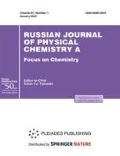Abstract
An analysis is performed of the state of a molecular theory oriented toward describing three-aggregate systems from a single viewpoint that includes their three bulk phases and three types of interfaces (vapor–liquid, solid–vapor, and solid–liquid). It is established that the theory, which is based on the lattice gas model (LGM), provides a common structure to express the pressure of not only three different bulk aggregate states but in their transitional regions of interface boundaries. The existence of vacancies in the LGM allows it to be used for all concentrations of the components of a multicomponent mixture from zero (which is characteristic of rarefied gas) to unity (in mole fractions) (which is characteristic of solids). Mechanical characteristics are calculated for heterogeneous systems using equations of local partial isotherms with the same structure in different regions of a common heterogeneous system. General expressions are derived for the pressure in different aggregate phases and the local pressure in the transitional regions of the three interfaces, through which local pressures the surface tensions of diverse interfaces are determined.
Similar content being viewed by others
REFERENCES
I. P. Bazarov, Thermodynamics (Vysshaya Shkola, Moscow, 1991) [in Russian].
G. F. Voronin, Principles of Thermodynamics (Mosk. Gos. Univ., Moscow, 1987) [in Russian].
J. O. Hirschfelder, Ch. F. Curtiss and R. B. Bird, Molecular Theory of Gases and Liquids (New York, 1954).
E. A. Mason and T. H. Spurling, The Virial Equation of State (Pergamon, Oxford, 1969).
C. Heer, Statistical Mechanics, Kinetic Theory, and Stochastic Processes (Academic, New York, 1972).
N. W. Aschcroft and N. D. Mermin, Solid State Physics (Holt, Renehart, and Winston, New York, 1976).
J. Mayer and M. Goeppert-Mayer, Statistical Mechanics (Wiley, New York, 1961).
N. A. Smirnova, Molecular Solutions (Khimiya, Leningrad, 1987) [in Russian].
D. V. Gibbs, Thermodynamics: Statistical Mechanics (Nauka, Moscow, 1982).
T. Hill, Statistical Mechanics;Principles and Selected Applications (Dover, New York, 1987).
N. N. Bogolyubov, Problems of Dynamical Theory in Statictical Physics (Gostekhteorizdat, Moscow, 1946; Intersci., New York, 1962).
F. P. Buff, Z. Electrochem. 56, 311 (1952).
A. G. McLellan, Proc. R. Soc. London, Ser. A 213, 274 (1952).
S. Ono and S. Kondo, Molecular Theory of Surface Tension in Liquids (Springer, Berlin, 1960).
J. Rowlinson and B. Widom, Molecular Theory of Capillarity (Oxford Univ. Press, Oxford, U.K., 1978).
J. E. Lane, Aust. J. Chem. 21, 827 (1968).
B. N. Okunev, V. A. Kaminskii, and Yu. K. Tovbin, Kolloidn. Zh. 47, 1110 (1985).
Yu. K. Tovbin, Zh. Fiz. Khim. 66, 1395 (1992).
Yu. K. Tovbin, Theory of Physical Chemistry Processes at the Gas–Solid Interface (CRC, Boca Raton, 1991).
Yu. K. Tovbin, The Molecular Theory of Adsorption in Porous Solids (Fizmatlit, Moscow, 2012; CRC, Boca Raton, 2018).
Yu. K. Tovbin, Small Systems and Fundamentals of Thermodynamics (Fizmatlit, Moscow, 2018; CRC, Boca Raton, 2018).
Yu. K. Tovbin, Russ. J. Phys. Chem. A 80, 1554 (2006).
I. Prigogine and R. Defay, Chemical Thermodynamics (Longmans Green, London, 1954).
Yu. K. Tovbin, Russ. J. Phys. Chem. A 90, 1439 (2016).
Yu. K. Tovbin, Russ. J. Phys. Chem. A 92, 2424 (2018).
Yu. K. Tovbin, Russ. J. Phys. Chem. A 93, 1662 (2019).
Yu. K. Tovbin, Russ. J. Phys. Chem. A 94, 270 (2020).
Funding
This work was supported by the Russian Foundation for Basic Research, project no. 18-03-00030a.
Author information
Authors and Affiliations
Corresponding author
Additional information
Translated by L. Chernikova
APPENDIX
APPENDIX
The free energy of a fully distributed heterogeneous lattice system is expressed as \(F(s) = \sum\nolimits_{f = 1}^M {\sum\nolimits_{i = 1}^s {\theta _{f}^{i}} } M_{f}^{i}\), where 1 ≤ f ≤ М, М is the number of system sites, function \(M_{f}^{i}\) determines the contribution made by i particles to the free energy of a system for a site with number f (for simplicity, the interactions between nearest neighbors are written) [20, 22, 24]
where \(\theta _{f}^{i}\) is the probability of an i component being at an f site; \(\theta _{{fg}}^{{ik}}\) is the probability of two components i and j being at neighboring sites f and g; \(\nu _{f}^{i}\) is the one-particle contribution to the free energy of the i component, \(\hat {\theta }_{{fg}}^{{ik}} = \theta _{{fg}}^{{ik}}\exp ( - \beta \varepsilon _{{fg}}^{{ik}})\), β = (kT)–1; \(\varepsilon _{{fg}}^{{ik}}\) is the energy of i and j components interacting at neighboring f and g sites; and k corresponds to one component of the mixture (the main sort of particles being 1 ≤ k ≤ s, k ≠ i). The particular number of k is unimportant, due to the ease of solving the problem. The above functions are defined as the average over the ensemble of identical heterogeneous lattices, for which the following normalization relations are satisfied: \(\sum\nolimits_{i = 1}^s {\theta _{{fg}}^{{ij}}} = \theta _{g}^{j}\), \(\sum\nolimits_{j = 1}^s {\theta _{{fg}}^{{ij}}} = \theta _{f}^{i}\), \(\sum\nolimits_{i = 1}^s {\theta _{f}^{i}} = 1\).
The molecular distribution in the quasi-chemical approximation (\(\hat {\theta }_{{fg}}^{{ij}}\hat {\theta }_{{fg}}^{{kl}} = \hat {\theta }_{{fg}}^{{il}}\hat {\theta }_{{fg}}^{{kj}}\)) is found from the solution to the equations for local partial isotherms [19, 22]:
The relation g ∈ zf is the sum over all nearest sites of the central f site. For the layered structure of the interface, this sum becomes z = \(\sum\nolimits_{p = q-1}^{q + 1} {{{z}_{{qp}}}} \), where z is the number of the neighboring sites in the bulk phase, and zqp is the number of sites in the р layer relative to the central site in the q layer. For the bulk phase,
The Gibbs potential of the fully distributed heterogeneous lattice system is defined through the above functions as \(G(s) = \sum\nolimits_{f = 1}^M {\sum\nolimits_{i = 1}^s {\theta _{f}^{i}} } \mu _{f}^{i}\), where
In the bulk, expression (A.4) for μi becomes the expression for Mi (A.3).
Rights and permissions
About this article
Cite this article
Tovbin, Y.K. Extending the Equation of State for Three-Aggregate Systems to Their Interfaces. Russ. J. Phys. Chem. 94, 2391–2395 (2020). https://doi.org/10.1134/S0036024420110291
Received:
Revised:
Accepted:
Published:
Issue Date:
DOI: https://doi.org/10.1134/S0036024420110291


